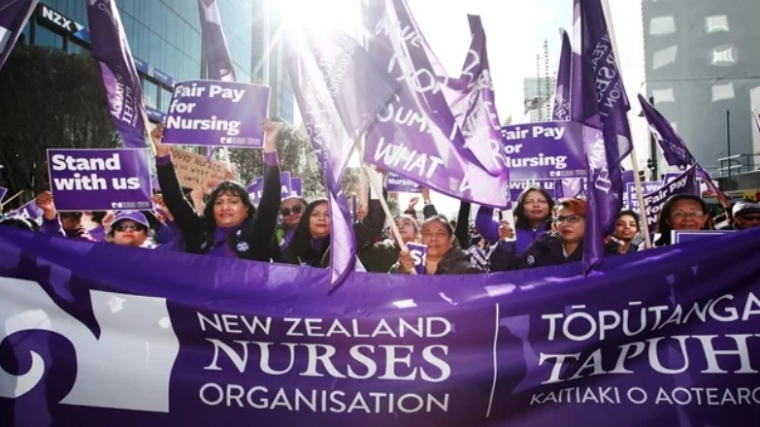
By Chris Trotter*
If you're talking about strike action in New Zealand, then 100,000+ is an impressive number of strikers. Less impressive, however, is the fact that nearly all the participants in this strike will be health and education sector workers. Yes, the collective contribution of these workers is absolutely vital to society’s proper functioning. But, paradoxically, this makes them weaker, not stronger.
Everyone knows, not least the striking workers themselves, that their actions can only ever be declaratory. Any cessation of work cannot be prolonged because the long-term withdrawal of services by nurses, doctors, medical technicians, and teachers would precipitate a profound social crisis.
The sick and injured must be tended. Children must be educated. An indefinite withdrawal of labour by the professionals responsible for supplying these indispensable services would provoke instant public fury and ruthless state reprisals. It is simply not a realistic proposition: the ordinary citizen knows it; the government knows it; the workers themselves know it.
So, why are the members of the health and education sector unions joining together on Thursday, 23rd October 2025 to produce one of the largest strikes in New Zealand history?
The brutal answer is that after months of negotiation the unions have failed to secure an acceptable settlement from their state employers. Essentially, Thursday’s strike is a cry of protest at what health and education sector employees regard as inexcusable government parsimony.
The strikers are hoping that their strictly limited industrial action will alert the public to how seriously the relationship between the state and its employees has deteriorated. Their intention is to use the resulting public concern to lever significant concessions from the Coalition Government.
This is the time-honoured way the state and state-sector unions have reached a settlement. The state agencies engaged directly in the negotiations test the mettle of the unions seated on the other side of the bargaining table. Are they in a concessionary frame of mind? Are there clear signals of a willingness to settle? Or is intransigence the order of the day? And, if so, how willing are they to fight?
These questions are political. No government enters into negotiations with its employees with a firm and premeditated intention of provoking strike action. If it is at all possible to reach a settlement, then the state’s negotiators will be encouraged to do exactly that. It is only in the most constricted of fiscal circumstances that governments make it clear to those negotiating with the taxpayers’ money that there is a line that must not be crossed, and they must hold it. If the unions want more, then they will need to demonstrate that they are in possession of the social licence required to extract it.
The winner of the ensuing battle will be the side which proves most adept at winning the hearts and minds of the public.
In this regard the education sector is lagging well behind its sisters and brothers in the health sector. Education is emerging as one of the very few success stories of the Coalition Government. As Education Minister, National’s Erica Stanford has not only reported real progress in lifting the reading and numeracy competences of young New Zealanders, but in doing so she has also exposed the arguments of the teachers’ unions as ideological not pedagogical.
Rather than have at the unions with the usual Tory cudgels, Stanford, with considerable political shrewdness, has allowed them to condemn themselves out of their own mouths. Letting it be known that the No. 1 item on the PPTA’s shopping list was Palestine needed nothing further by way of ministerial commentary. If politics is the language of priorities, then the secondary-school teachers would clearly benefit from an intense course of remedial reading.
The Coalition’s handling of health is, however, a very long way from being a success story. Removing the portfolio from Dr Shane Reti and placing it in the hands of Simeon Brown – presumably with the intention of reining-in costs – shows little sign of bearing edible fruit. Given the sheer scale of the sector’s disarray (thank you once again Andrew Little!) the politically smart move by Luxon’s government would have been to cushion the ongoing blows of institutional readjustment by approving generous increases in Vote Health.
Finance Minister Nicola Willis foreclosed that option by pressing ahead with National’s promised tax cuts. By doing so, she more-or-less mandated the industrial strife which now threatens to draw in virtually the entire health workforce.
Willis is fortunate to have in Brown a politician who understands the nature of the game he has been told to play. Never one to step back from a fight, the Health Minister has gone on the offensive against the health unions, accusing the Association of Salaried Medical Specialists of “crossing an ethical line” by joining in the strike action. A day later, the Minister speculated that it may be time to outlaw strikes by doctors altogether. Brown also decided to release the salary stats (possibly padded by overtime and allowances) of the state’s medical professionals to the general public.
The doctors’ complaints about Health NZ’s offer not keeping pace with the cost-of-living must have rung a little hollow in the ears of those at or below the annual median income of $71,000. When the state’s doctors are earning at least four times that figure it is most unlikely that the high cost of butter is acting as too much of a drag on their pursuit of happiness.
New Zealanders know that Health is in trouble, the evidence is all around them. What gives them greater pause, however, is whether, in a country without a lot of fiscal room to move in, now is really the best time to give in to health workers’ demands. After all, for the 85 percent of New Zealanders working outside the protection of a trade union, there’s scant evidence of generosity getting the better of their own employers.
For the first time in a very long time, there is a reasonable chance that if the Ministers of Education and Health are willing to stand firm and avoid the urge to blink, then they will be able to inflict a decisive victory on the unions of both sectors.
The almost universal goodwill upon which the education and health unions have hitherto relied, and been able to draw, may no longer exist. If it has indeed dissipated and diminished, then the social licence the unions were formerly so certain of securing may not be there to waft under the ministers’ noses.
It has, perhaps, not occurred to the President-elect of the NZ Council of Trade Unions, Sandra Grey, or to all the other well-educated, well-heeled trade union leaders whose skills were honed in the public sector, that more than 92 percent of private sector workers are now outside the union movement.
For these men and women: the courier drivers, shop assistants, warehouse workers and hospo staff; the salary levels, holidays, automatic increments and generous allowances of middle-class, white-collar workers in the public sector are the stuff of dreams.
It is more than 30 years since the passing of the Employment Contracts Act. A whole generation has grown up and entered the workforce without even the memory of solidarity and struggle. In the modern private sector workplace, the norm is self-reliance, and the cry of “Out brothers, out!” is just a line their fathers remember from a 1970s hit by The Strawbs.
One-hundred-thousand strikers there may be on Thursday, 23rd October, but whether they turn out to be 100,000 winners must, for now, remain an open question.
*Chris Trotter has been writing and commenting professionally about New Zealand politics for more than 30 years. He writes a weekly column for interest.co.nz. His work may also be found at http://bowalleyroad.blogspot.com.
4 Comments
"......Children must be educated....."
Given teachers love of the so called teacher only days and the manipulations of teachers to close out the end of year finish as early as possible - it's clear the teachers don't agree about the children.
The public salaries an conditions are right out of line with similar workers.
The unions are shooting themselves in the foot.
Allied health workers (physios, occupational therapists, radiologist etc.) and nurses subsidised the health system through steadily declining wages for decades. This situation was only recovered a couple of years ago with substantial pay increases.
Tax payers wanted their tax cuts, but the downside is a broken health system. This round of industrial action is to try and maintain conditions for health workers (and teachers etc.) so that these careers stay attractive to the next generation coming through.
The alternative is further privatisation of the health system, and health insurance for all. America has shown us that that is the least efficient way to run a health system.
I've always wondered what the cushy nursing jobs get paid? The ones at yr GP who have an easy 8:30 to 4:30 or so work day and of course no week-ends. Our GP Centre has nurses in the +50 age group. Maybe that's the job nurses aspire to once they've done the hard yards in a hospital. A few years ago when i was hospitalised at TBH quite a few of the nurses were from South India. English some problem. Before a canula insertion into the back of my hand I mentioned I had wriggly veins, a term I picked up and understood from a nurse with English as her home language. This expression was lost on the South Indian nurse who then had to call someone more familiar with inserting canulas into wriggly veins.

We welcome your comments below. If you are not already registered, please register to comment.
Remember we welcome robust, respectful and insightful debate. We don't welcome abusive or defamatory comments and will de-register those repeatedly making such comments. Our current comment policy is here.